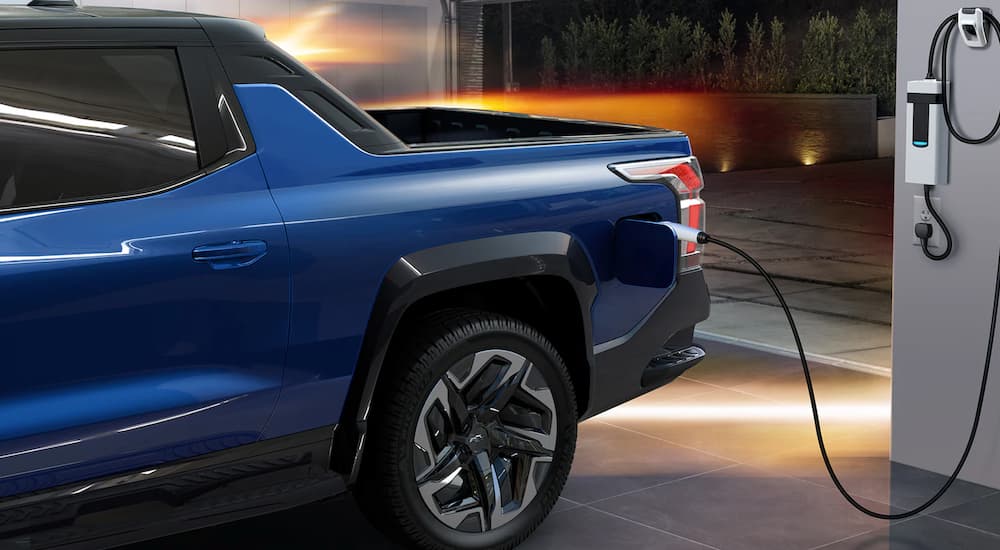It seems that 2022 is the year the truck world goes electric, and after months of teasing, Chevy has finally raised the curtain on the 2024 Chevy Silverado EV. Following the reveal of avant-garde designs like the Tesla Cybertruck, GMC Hummer EV, and Rivian R1T, as well as the mainstream look of the Ford F-150 Lightning, we weren’t quite sure which way Chevy would go with its first electric truck, but we definitely weren’t expecting something that strongly reminded us of the old Chevy Avalanche. Bold move Chevy, but truck drivers may be the most image-conscious members of the automobile world, and we aren’t sure if even a 4.5-second zero to sixty time is going to make the public embrace a truck with a unibody look.
Unlike Ford, which simply shoved a bunch of batteries between the frame rails of a standard F-150 chassis to create the electric F-150 Lightning, Chevy designed the Silverado EV from the ground up to be an electric truck. In fact, the Silverado EV doesn’t share a single part with the standard gas and diesel Silverado. Instead, it is built on GM’s much-hyped Ultium platform, which was first unveiled for the GMC Hummer EV. That means a unibody design riding on a “skateboard” battery pack, much like almost every other EV on the market. However, unlike the Rivian R1T, which uses a similar unibody design but conceals it with the cab and bed meeting at right angles, Chevy decided to copy the sloping C pillars of the defunct Chevy Avalanche.
In fact, that wasn’t the only thing Chevy copied from the old Suburban-based pickup. Likely knowing that truckers everywhere would be left grumbling 5-foot 11-inch bed (the unibody design means the Silverado EV is only available as a crew cab with the single bed length), Chevy brought back the cab pass-through from the Avalanche as well. Fold up the wall separating the cab from the bed, and the Silverado EV can accommodate cargo measuring up to 9-feet in length: 10-feet if you lower the bed and use the Multi-Flex Tailgate’s built-in load stop.

How Does It Perform?
Enough about the looks–does the Silverado EV live up to the Silverado name when it comes to performance? It depends on what you are looking for. Do you want a comfortable and efficient commuter that can outrun sports cars while towering over traffic? Then this is the truck for you. The RST trim finally lives up to its name, offering 660 horsepower and 780 lb-ft of torque from a pair of electric motors (that’s roughly the performance of the GMC Hummer EV 2X trim for those of you cross-shopping the two models). Add in the absolutely ridiculous 17-inch infotainment touchscreen (and matching 11-inch driver display) and four-corner air-ride suspension, and this is one luxurious truck that is built to perform–just be prepared to pay over $100k to drive it.
But if you are looking for a real work truck designed to haul heavy loads and get dirty, then the Silverado EV probably won’t be the truck for you. Although Chevy has promised a WT trim that starts at just under $40k and comes with slightly less over-the-top performance, neither the WT or RST offers particularly impressive work bona fides. Towing is estimated to come in at 10,000 lbs for the RST or 8,000 lbs for the WT, putting the Silverado EV squarely in line with the F-150 Lightning and 1,000 lbs behind the Rivian R1T. Payload is another story, however. The Silverado EV is expected to top out at just 1,300 lbs, which leaves it 700 lbs short of what the Lightning can haul and 460 lbs behind the smaller Rivian. Given the size and price of the Silverado EV, those numbers aren’t great.
There is one number that does stand out, though: 400 miles, the expected range. If true, that would mean that Chevy’s truck has nearly a 100-mile range advantage over the Ford and Rivian. The number isn’t terribly outlandish either, given that Chevy has loaded the Silverado EV with an incredible 200 kWh of batteries. Ford and Rivian both use battery packs in the 130 kWh range, which allows them to have lower prices, lower curb weights, and higher payloads. It also means that the Silverado EV is likely the least efficient electric vehicle you can buy, so buyers need to be ready for some eye-watering electrical bills.
The EVs Are Coming
The Silverado EV may not be our first choice among the new electric trucks hitting the market; it’s probably not even our second, third, or fourth choice. However, it is a big step forward for a brand whose only EV to date is the underwhelming (and highly flammable) Bolt EV. The Silverado EV is sure to impress when it hits the road, but it remains to be seen if it will be able to live up to the reputation of the gas and diesel Silverado or be able to claim the same level of market share. We’re hopeful that it does, but we’re not putting out money on Chevy just yet.





